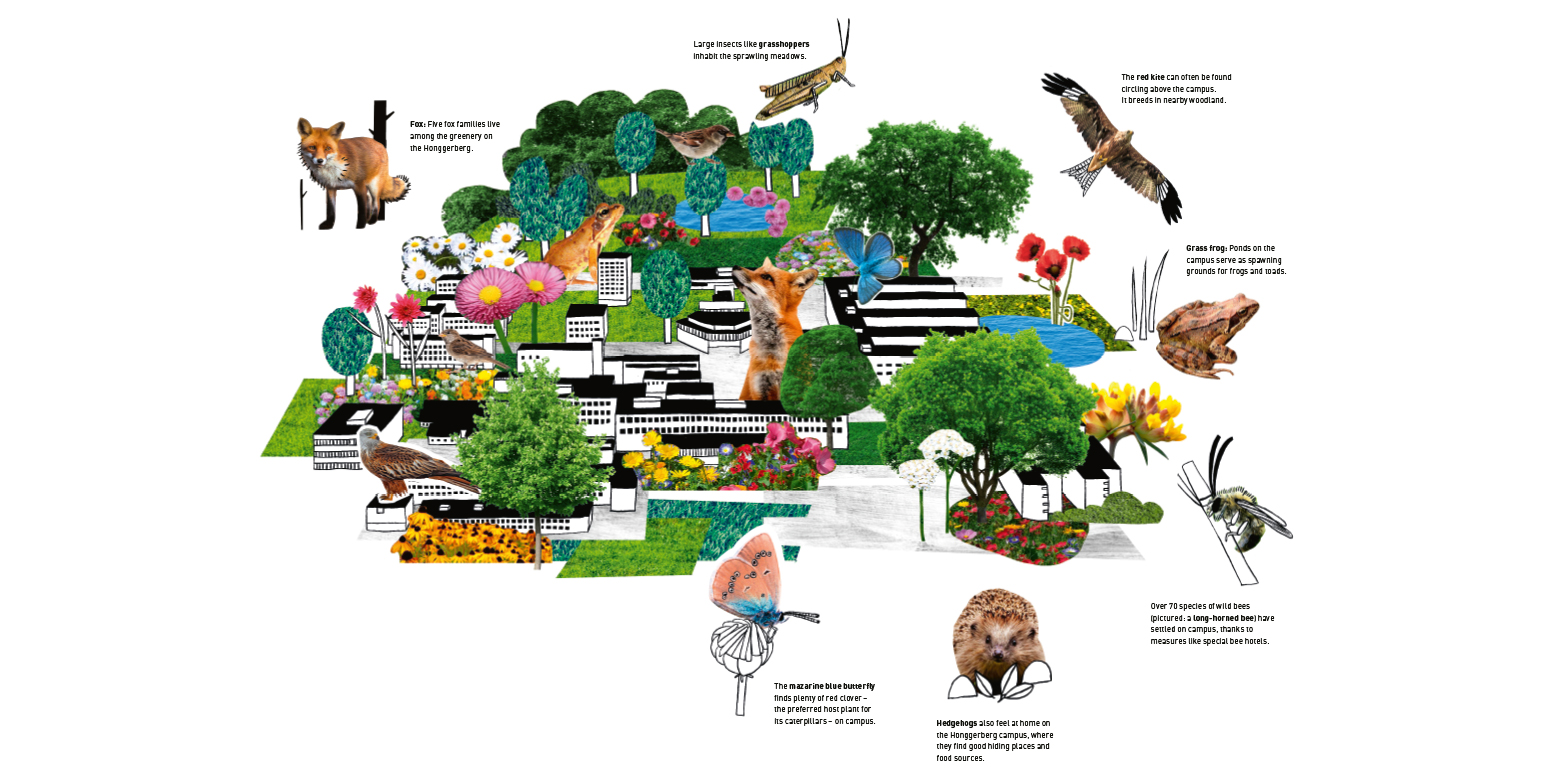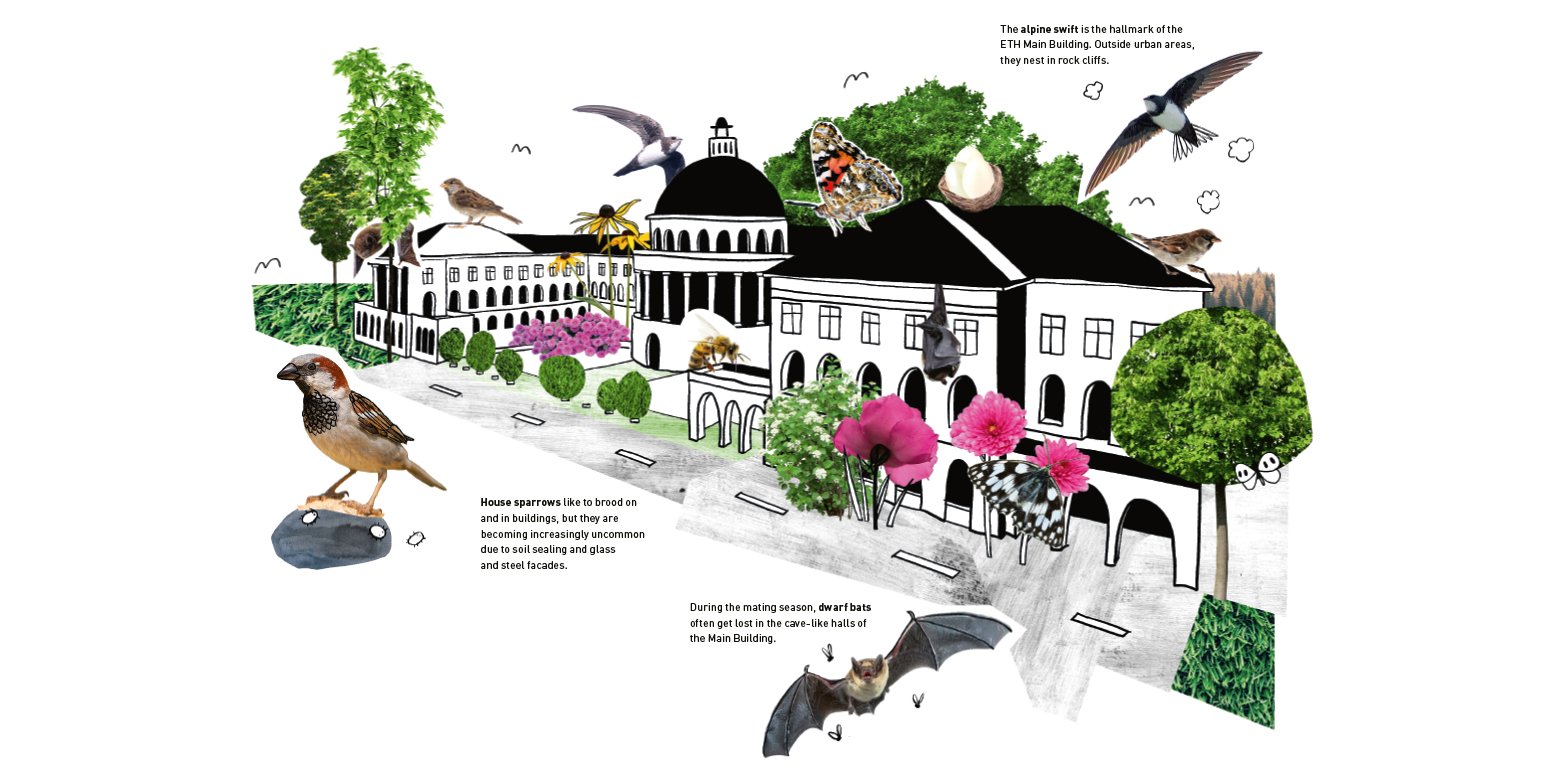The ETH Zurich Zentrum and Hönggerberg campuses are not just the study and office spaces of the 30,000 members of ETH: they are also home to a variety of animals and plants. ETH is taking steps to preserve the biodiversity on its sites.
From the violet meadow sage and the pink sainfoin to the yellow anthyllis and the red poppies: wild flowers in vibrant spring colours light up the path along the south facade of the HCI building. A bumblebee dips into a sage bloom to extract the sweet nectar. The Hönggerberg campus is not just a hub of science. It is also home to all manner of animals and plant life, serving as a space for biodiversity within a settlement area.
Biodiversity – that is, the variety of life – is an important issue in today’s world. At the start of May this year, the Intergovernmental Science-Policy Platform on Biodiversity and Ecosystem Services (IPBES) warned of the accelerated extinction of biological species. An IPBES press release reported that up to one million of a total of eight million species are at risk. In the face of statistics such as this, it is important to consider the biodiversity at the ETH Zurich sites and to think about the steps the university is taking to maintain and promote the variety of species it plays host to.
Biodiversity on the Hönggerberg campus
Depending on the time of year, you’ll find a whole host of insects with weird and wonderful names while roaming around the ETH campus, such as bush crickets, grasshoppers or southern hawker dragonflies. You’ll also find birds, from house sparrows fighting over crumbs on the main square to wood pigeons with bright white patches on their throats, or the inconspicuous spotted flycatcher hunt¬ing insects from the treetops. Red kites and hobbies can also be spotted from time to time wheeling across the sky.
Situated close to forest areas and suitable spawning waters, ETH’s Hönggerberg campus is also an important habitat for amphibians in the city area. In the spring, alpine newts, common toads and common frogs set out on their travels, with the ponds near the sports hall being one of their favourite haunts. Mammals, too, feel right at home on the campus. Hedgehogs, badgers and foxes have made their homes there, and deer cross over from the Käferberg to the Hönggerberg forest.
Dedication pays off
One reason for this variety of species is the fact that the green spaces at ETH Zurich have been ecologically enhanced and maintained for many years. Fritz Graber has been responsible for looking after these areas on the Hönggerberg campus for almost 20 years. Together with one member of staff and external gardeners, he cultivates 6 hectares of turf, sports fields and alkaline grassland, as well as 13 hectares of meadowland. This area is not fertilised and is only mowed two or three times a year to enable biodiversity to thrive. Green area managers at ETH also maintain 1,300 trees on the Hönggerberg campus, including ecologically valuable deciduous trees such as oaks. As a reward for its efforts, the Hönggerberg campus has twice been recognised as a “nature park of the economy” by the Stiftung Natur & Wirtschaft association for nature and economics.
Graber certainly hasn’t been resting on his laurels. At the instigation of Zurich-based green initiative Grün Stadt Zürich, he had a dozen native fruit and nut trees planted around the SeedCity garden. These trees are an important element in ensuring biodiversity.
Special measures had to be taken in order to protect the amphibians. ETH employees covered all shafts on the buildings with finely woven wire mesh or installed escape routes for the animals, saving the lives of hundreds of frogs, toads and newts.
Biodiversity is also being encouraged on the rooftops – the most recent example of this being the roof renovation on the HPM building. The gardeners added pioneer plants to the roof, itself covered in a variety of substrates. These plants are able to withstand dryness and heat. A variety of wild bees and plants which wouldn’t otherwise be found on the campus benefit from such low-humus and dry areas.
“Artificial crag” attracts bats
The Zentrum campus also showcases the value of committing to biodiversity. Flowering groves and wild bee hotels have been created in a number of the green areas, with a pocket of land having recently been established at the Haldenbach computer centre. A roadside embankment on the Karl-Schmid-Strasse has also been ecologically enhanced for some time. An array of sumptuous blooms have blossomed at both sites, attracting bumblebees and wild bees.
The Main Building is also interesting from an ecological point of view, serving as a rocky landscape for certain varieties of birds and bats, with cracks and crevices providing the animals with shelter and nesting spaces. Alpine swifts are particularly prominent during the summer period. These swallow-like birds dart around the Main Building where they have their nesting areas, warbling loudly as they go. Their smaller, dark-feathered relative, the common swift, also uses the site as its breeding ground. The Main Building is not necessarily the obvious choice, but modern glass and steel buildings (like some at ETH) no longer provide birds like swifts and house sparrows with space for nesting.
The Main Building also attracts other flying creatures: 3 of the 15 species of urban bat can be found here. These bats are usually common pipistrelles or Nathusius’ pipistrelles, although Kuhl’s pipistrelles have also been spotted in the last 20 years or so. They can be seen hunting at twilight over the green areas surrounding the Main Building.
The bats’ preference for the “artificial crag” does, however, have a downside: on mild nights, the bats manage to make their way into the building through open skylights – but then they often have a hard time getting out again. ETH members later find the animals weak, thirsty and listless. Touching them with bare hands is out of the question, as just a single bite could spread rabies. The best course of action is to call building services or the specialists at the Swiss bat protection foundation.
Preserving biodiversity capital
ETH still has some way to go in its mission to promote biodiversity, for example, in terms of light pollution. A new approach to exterior lighting is currently being implemented at the Hönggerberg campus. The intention is to predominantly use LED lights with minimal blue and AV light content so as not to disrupt the animals’ biological clocks. The lights should also only shine downwards in order to prevent light pollution. “The implementation of the lighting concept is yet another piece in the puzzle of finding sustainable ways to maintain biodiversity,” says Dominik Brem, Head of the Building Technology and Sustainability specialist unit.
Increasing building activity is a critical problem for the variety of species in urban habitats, as it results in soil being permanently sealed. Urban ecologist Christoph Küffer of the Department of Environmental Systems Science believes ETH must ensure that it integrates ecological qualities into both the planning and architecture phases of construction in order to preserve sufficient biodiversity capital.
“Densification, soil sealing and a lack of shelter and nesting spaces in modern buildings have led to a reduction in the quality of biodiversity, both in the city and on ETH sites,” says Küffer. According to Küffer, the Hönggerberg campus has a good starting point for further improvement, with its green environs, old trees and expansive surrounding meadows: “This strong foundation should be better utilised in order to get the most out of it for the wild animals and plant life that call it their home.”
This article appeared in the current ETH magazine «life».
What you can do to help promote biodiversity:
- Plant more native shrubs, bushes and trees in your own garden
- If possible, turn your lawn into a natural meadow: don’t use fertiliser, only cut it two to three times per year and don’t mow under bushes to avoid harming any hedgehogs living there
- Set up nesting aids for birds and wild bees
- Avoid using unnecessary exterior lighting and use LED lights instead of lights with a high blue light content
- Create retreats for wild animals in your garden: compost heaps, clumps of branches, stones, small walls
- Remember: Free-roaming cats pose a threat to wild animals living in urban areas, particularly in the spring and summer months when these animals are raising their young
- Don’t feed wild animals


Comments
No comments yet